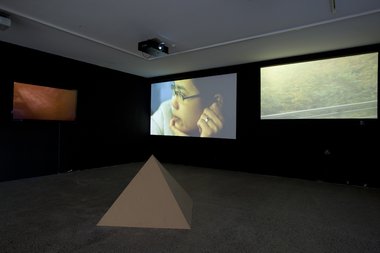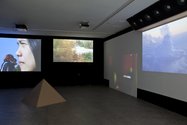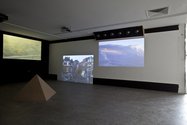John Hurrell – 27 December, 2011
There is clearly more to this than just the recycling of home movies. The installation is quite formally organised with a considered positioning of filmic abstract elements. One screen emphasises abstract lines of blurred city lights, others non-English languages as a kind of aural texture; another scenes of Moore and a friend moving inanely in circles.
Auckland
Tahi Moore
I guess you’d call it a video composition with pyramid and beats
26 November 2011 - 29 January 2012
As Tahi Moore installations go, this current project at Te Tuhi (with its calculatedly vague title) is a comparatively accessible and uncomplicated affair - unlike the richly modified appropriated movies and jarring juxtapositions he used to show at Gambia Castle or ACFA, or even the oblique set of hermetic references he recently presented at Hopkinson Cundy.
The Te Tuhi space, with its three wall projections, one plasma screen and one old fashioned monitor - all at different heights, along with a four sided plywood pyramid in the middle and a line of five speakers set high up the wall near the ceiling - spatially emphasises two corners which four DVD screenings are butted up against and around. The dominant narrative theme is a few weeks of air and train travel in Europe, apparently France and Germany, his wife peering at various tourist sights, and documentation of temporary living spaces like hotel bedrooms and bathrooms.
Yet there is clearly more to this than just the recycling of home movies. The installation is quite formally organised with a considered positioning of filmic abstract elements. One low screen emphasises abstract lines of blurred city lights, others muffled recording of non-English languages as a kind of aural texture; another scenes of Moore and a friend in an enclosed space moving inanely in circles.
I like this work for reasons that have very little to do with what I think Moore’s intentions might be - though of course I could be underestimating his imagination. The images become memory aids, reminding me of many trips I took in the early nineties (while living in Europe) on trains between France and countries on its eastern borders - particularly the shots of Parisian suburbs, German woods and small towns in little valleys. They capture the wondrous nature of seeing cultural manifestations you have only previously read about or seen in mass media, but not experienced - even though looking out of train or bus windows is hardly a direct encounter.
There is a connected sense of irony here because although it is amazingly liberating for New Zealanders to visit Europe and explore, this exhibition has an ambience of claustrophobia that goes beyond the contingencies of Te Tuhi’s architecture and how that affects Moore’s imagery. There is a feeling of ‘outsiderness’ that I think Moore intends that comes from living at the bottom of the Southern hemisphere, not knowing European languages, and so like any fast-moving itinerant traveller, not really getting beyond the immediate surface of things. The pyramid becomes a marker for Aotearoa: this place as foil.
This dominant theme of transience and lack of depth beyond outer textures, the inability to genuinely transcend distance, makes the show subtly disturbing while also pleasurable - because the frustrating limitations of whirlwind travel (far better than staying bored at home) are acknowledged right from the start. In other words: unavoidably bittersweet.
John Hurrell







 Two Rooms presents a program of residencies and projects
Two Rooms presents a program of residencies and projects Advertising in this column
Advertising in this column



This Discussion has 0 comments.
Comment
Participate
Register to Participate.
Sign in
Sign in to an existing account.